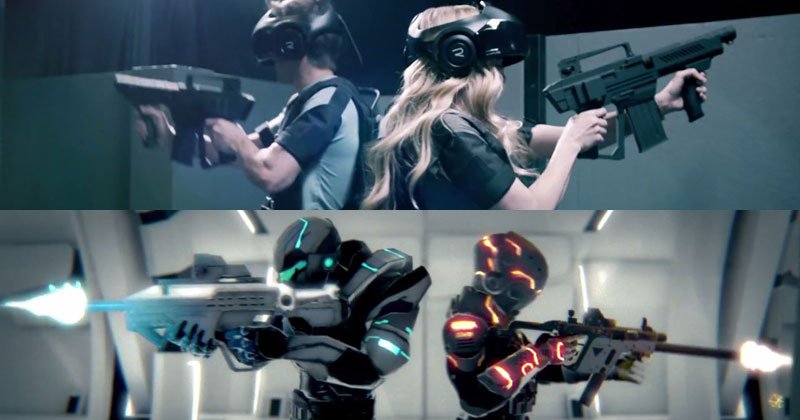-

-

-

-

-

-

-

-

-

-

-
-

-

-

-

-

-

-

-

-

-

-

-

-

-

-

-

-

-

-

-

-

-

-

-

-

-

-

-

-

-

-
-

-

-
 TOTW: Google's Project Ara Modular Phone May Be The Future Of SmartphonesOctober 30, 2014
TOTW: Google's Project Ara Modular Phone May Be The Future Of SmartphonesOctober 30, 2014 -

-

-

-

-

-

-

-

-

-

-

-

-

-

-
-
-

-

-

-

-

-

-

-

-

Posts tagged Oculus Rift
Augmented vs. Virtual Part 1 – Virtual Reality
19 years
Technologically enhanced vision has been with us for many hundreds of years, with eyeglasses having been in use since at least the 14th century. Without effective sight, living has of course remained possible during this era, but it is a meaningful disadvantage. Now, new technologies are offering the promise to not only make our lives easier, but to also give us new capabilities that we never thought possible.
This idea, enhancing our vision using technology, encompasses a range of technologies, including the two promising arena of augmented reality (AR) and virtual reality (VR). The names are fairly self-explanatory; augmented reality supplements and enhances your visual reality, while virtual reality by contrast creates a whole new reality that you can explore independently of the physical world. Technically, AR hardware generally consists of a pair of glasses, or see-through panes of glass attached to hardware, which runs software that projects translucent content onto the glass in front of you. VR, on the other hand, is almost always a shoebox/goggle-like headset, with two lenses allowing two different screens in front of your eyes to blend into one, using head motion-tracking to make you feel like you are in the virtual world. Both are very cool to experience, as I experienced while attending the Augmented World Expo last week in Silicon Valley, where I have able to demo a host of AR and VR products. This article focuses on my experiences with Virtual Reality gear; next week I will follow-up with thoughts on Augmented Realty.
Virtual Reality
Virtual reality, when combined with well-calibrated head-tracking technology, allows you to be transported into a whole new world. You can turn your head, look around, and the software responds as if this world is actually around you, mimicking real life. This world can be interactive, or it can be a sit-back-and-relax type experience. Both are equally astounding to experience, as the technology is advanced enough so that you can temporarily leave this world and enter whatever world is being shown on your head mounted display (HMD). I wrote about a great use-case of VR at the AWE Expo recently, which involved being suspended horizontally and strapped into a flight-simulation VR game.
Despite what you might think, the optics no longer seem to be a problem, as the engineers at early leaders including Oculus and Gear VR have designed headsets that don’t bother our eyes during use, a problem that plagued early models. That said, complaints persist about vertigo and eye-strain from long periods of use. Even Brendan Iribe, Oculus CEO, got motion sickness from their first Dev kit. Luckily, but his company and others have been making improvements to the software. Personally, I didn’t get sick the least bit while at the conference.
Uses for VR, among many, tend to fall in one major category thus far: entertainment. Video games are set to be transformed by virtual reality, which promises to bring a new dimension into what could be possible in a gaming experience. First-person shooters and games of that like were already trying to become as real and immersive as possible on a flat screen, but with a 360-degree view around the player, and interactive head-tracking… well, it’s surprising that games like Halo, Destiny and Call Of Duty don’t already have VR adaptations. And games with a more artistic themes and play will also benefit greatly in using VR rather than 2D screens, as adding the ability to look around and feel like you are in the game will surely spark ideas in many developer’s heads. At E3 2015, which took place this week in Los Angeles, many commented that virtual reality was an obvious trend in gaming this year, and excitement was starting to build about VR’s potential in gaming. While hardly a gaming exclusive environment, VR appears to be a promising tool for immersive military training as well. Nothing prepares a soldier or a pilot better for an on the battlefield or in the air situation better than already pseudo-experiencing it. The possibilities for gaming and military training are endless in terms of VR, and it really is exciting to see what developers are coming up with.
One thing that may hold VR back is the hardware. Despite having mitigated the vertigo issues, another hardware complaint has been weight. While the Oculus Dev Kit 2 is a little less than 1 pound, which isn’t much, but can be strenuous when wearing for a long period of time. Still, if we have learned anything from the growth of smartphones it’s that technology marches in one clear direction: smaller, lighter, and faster. And that’s one thing that I believe separates AR and VR: VR is already to the point that the only changes needed to be made will be upgrades to the existing hardware. The pixel density, the graphics speed, the weight, the size. Not to mention that in a few years, many of the major problems with VR will be solved, and this is something that I think separates it from AR.
Whereas all VR has to do is get the hardware right and then integrate head tracking software into their 3D games or movies, AR has a ways to go until has perfected its hardware to the same level as VR has. AR is frankly just harder for the developers. Not only do they have to worry about the pixel density, head-tracking, weight, and size like VR, but they have to worry about depth, the screen transparency, object recognition, 3D mapping, and much more. Currently, there isn’t one big AR player, like Oculus, that small developer teams can use as a platform for their own AR software, and that might also be limiting the growth of the technology. A big player may emerge in the next could years, with candidates including Google Glass and Microsoft’s upcoming AR headset HoloLens leading the race, but for now, AR isn’t really an area where small developing teams can just jump in.
In the grand scheme of things, AR and VR are at similar stages of development. Within a decade or two, these problems will vanish, and the technologies will be face-to-face, the only thing separating them is their inherent utility in particular situations. For VR, it is a technology that was made for entertainment and gaming. The idea of transporting yourself to another world, especially when the tech is fully developed and you can’t tell the difference between VR and real life, is as exciting as it is terrifying. Still, we can’t help but try to create these amazing games and experiences, as they very well may expand humanity into virtual world we never could have dreamed of. As developers start meddling with the technology, and consumers start buying units, VR will grow into many more markets, but for now, entertainment, gaming, and military training are the main uses. It really is a technology out of the future, and I can’t wait to see what amazing experiences and tools that VR will bring to the world next.
This is the first piece in a two-part series on AR vs. VR. Check back here soon for the second article!
Mindride’s Airflow Can Make You Fly – Well, Virtually
09 years
Humans can’t fly without technological assistance, but that hasn’t stopped us from building planes, helicopters, wingsuits, and more. Flying shows up in mediums ranging from comic books to myths and fairy tales to cultural folklore. From Icarus to Superman, humans have desired to fly. But as technology has advanced, watching people fly hasn’t satisfied us; now we want to feel like we truly are flying, and in this respect technology is beginning to grant our wish, through Virtual Reality devices.
This morning, at the Augmented World Expo in Santa Clara, California, I got the opportunity to fly. In a unique booth at the Expo, a company called Mindride offered an experience, Airflow, that involved strapping myself into a harness, donning headphones and an Oculus Rift, and then flying Superman-style through a virtual Alps-like landscape. How could I say no? And so, after 5 minutes of harnessing and calibration, I was flung into this mountainous world, floating thousands of feet above the “ground.” Under me were mountains, some snow-capped, others green. Around me, randomly scattered in the sky, were big pink spheres. The objective of this experience was to steer yourself towards these spheres, trying not to flinch as you run right into them, and pop as many as possible. I have to say, I think I did pretty well, but the larger point is that current generation VR technology is enabling experiences that really can begin to replicate those that humans have dreamt of for centuries.
The booth was set up pretty unusually. With a desk off to the side, the majority of the space was taken up by this “ride”. Consisting of a couple of beams with straps, harnesses, and cords running everywhere, the infrastructure was pretty impressive but not exactly family room-ready. Before you got to experience the flying, you had to put sensors on each arm that track where you are pointing your arm in relation to your body. Once strapped in, I was hanging horizontally, with the computers gauging whether I was holding my arms straight back in boost mode, left arm out to go left and right arm out to go right, or both arms dangling to hover in place. On my head was an Oculus Rift running Airflow’s custom software. To add effect, there are two fans blowing air in your face, which vary how much air they blow based on your flight speed.
Overall, the experience was surreal. Once you are strapped in and flying, wind in your face, you easily forget your immediate surroundings, which in my case included a gaggle of tech entrepreneurs demoing their products. The immersion was astounding, andMindride did a great job making the experience more than a run-of-the-mill VR game. Of course, as it is with new technologies, there are clear hints that you aren’t truly flying across in amountain-filled world chasing pink bubbles. The occasional background noise interfered with the experience, as did my tendency to shift focus from the screen-wide image to pixel-level details. But again, as technology advances, these subtle distractions will be minimized; in fact, some solutions to the issues I had were even displayed Expo. As experiences like these gradually become more common in places like malls, theme parks, and even in our own homes, we will start to see a blending of reality, as we’ve always know it, and virtual reality – a reality in which anything is possible. It’s hard to doubt the demand for that.
The Void Brings Virtual Reality To Life
010 years
No doubt, virtual reality is a revolutionary technology in the field of gaming, military training, and more. Vision makes up so much of our reality that when it is altered or augmented, we can feel like we are in a totally different world, even if things are occurring in that world that we know can’t really happen (e.g., aliens attacking, cars flying, or dragons breathing fire). This is the power and potential of virtual reality products currently under development such as Project Morpheus and Oculus Rift; they can make you believe that you are living in a fantasy world.
The new post-beta Oculus headsets appear to represent a big step forward in immersive gaming, despite lacking one major ingredient in fully immersive gaming: the actual feeling of running away from an enemy, picking up objects, and jumping over a pit of lava. Although the experience is pretty good only augmenting your vision, that last step toward achieving something I would consider fully immersive is building a gaming system that made you physically feel like you are in the game. And that is exactly what Ken Bretschneider, founder of The Void, is trying to achieve.
“I wanted to jump out of my chair and go run around,” Bretschneider said. “I wanted to be in there, but I felt like I was separated from that world just sitting down playing a game. So I often would stand up and then I couldn’t do anything.” – Ken Bretschneider
Although still conceptual, the Void’s product is aiming to take virtual reality gaming to the next level. The idea behind the company is pretty simple: they will create “Void Entertainment Centers” that will use high-tech virtual reality technology, along with real, physical environments to create the ultimate VR experience. Sounds awesome.
The execution of this idea, however, is very complicated.
There are many technical obstacles to creating a fully immersive VR experience. First of all, you need state-of-the-art tracking systems, not only because it will make the experience more realistic, but also since you don’t want the players running into walls (or each other) because the VR headset lagged slightly or didn’t depict the object in the first place.
Also, the VR headset itself better be up to par, otherwise the whole experience itself isn’t worth it. According to The Void’s website, their “Rapture HMD” (head-mounted display) is as good as if not better than other VR headsets such as the recently announced Oculus Rift set for release later this year. With a screen resolution of 1080p for each eye, head-tracking sensors that are accurate to sub-millimeter precision, a mic for in-game communication, and high-quality built-in THX microphones, the Rapture HMD isn’t lacking in impressive specs. Whether it is ultimately good enough to feign reality, though, is a question that will only be answered when the headsets go into production and become part of The Void’s immersive experience.
The Void gear includes not only the HMD but also a set of special tracking gloves — to make your in-game hands as real as possible — and a high-tech vest to provide haptic feedback in response to virtual stimuli. But the technology alone does not suffice, as that is replicable outside of The Void. What would make the experience unique is the physical environment around the players and built into The Void’s Entertainment Centers. In each game center, the first of which is planned to be built in Pleasant Grove, Utah, there will be an array of different stages prepared for players to experience a variety of virtual games. In every “Game Pod”, there are features that make playing there more immersive, such as objects you can pick up and use during the game, elevation change in the platforms, and even technologies that simulate temperature changes, moisture, air pressure, vibrations, smells, and more. All of these mental stimuli outside of the game will be designed to trick your brain into thinking it’s in the game, and that’s pretty much exactly the experience The Void is trying to provide.
Overall, The Void is a big step towards a new age in gaming. For as long as gaming has been around, the actual stimuli coming from the game has been purely vision and hearing based; now, incorporating real objects, physical surroundings, and the environment-based technologies mentioned above, we are nearing a complete immersive experience (a la Star Trek’s holodeck). Science fiction writers have long pondered virtual systems that realistically simulate other worlds, and The Void is potentially one step closer to that ideal. Whether or not we are heading rapidly in that sci-fi direction, for now the Void’s Entertainment Centers would certainly be a lot of fun.
TOTW: Omni Virtual Reality Treadmill
0Complete virtual reality is still something for the future, but many companies are trying to make this future come faster, including Google, Oculus Rift, Microsoft and more, but we are often still missing something very important: physical movement. Yes, there is motion-tracking like on an XBOX, but if you want to step into that virtual world and actually walk and jump around it like in Star Trek, you are – or were – out of luck. That’s where Omni comes in.
Omni is basically a treadmill. But better. Much better. Omni lets you roam free in video games that come for the Oculus Rift. No more hitting keys and looking at a screen. Paired up with the Oculus, Omni lets you walk through games such as Skyrim, Minecraft and Call Of Duty, while also looking around. Gaming will be transformed from sitting on a computer to actually sweating and running.
How does Omni take your movement and transport it into the game world? Well, the minute you step into Omni invisible magical leeches – erm, just kidding. Rather, you first don special motion-tracking shoes that give Oculus the information about how to move. It is not really a treadmill in the sense that the floor doesn’t move. But, the curve makes it easy to move around, jump, and run away from angry ogres. Secondly, there is a belt that keeps you from tripping and falling, which will be very important since this is such a new technology. And finally, the software.
You would think that the software for Omni would be really really complicated, due to the fact that you have to translate it into code that the Oculus understands. But it isn’t. The programmers were tricky. They coded it so that your foot movements get translated into key strokes, making it easy on the Oculus. Plus, the Omni software for Kinect for Windows understands many more movements including crouching, jumping and some arm gestures. With Omni and Oculus Rift combined, virtual reality is even closer than ever.






